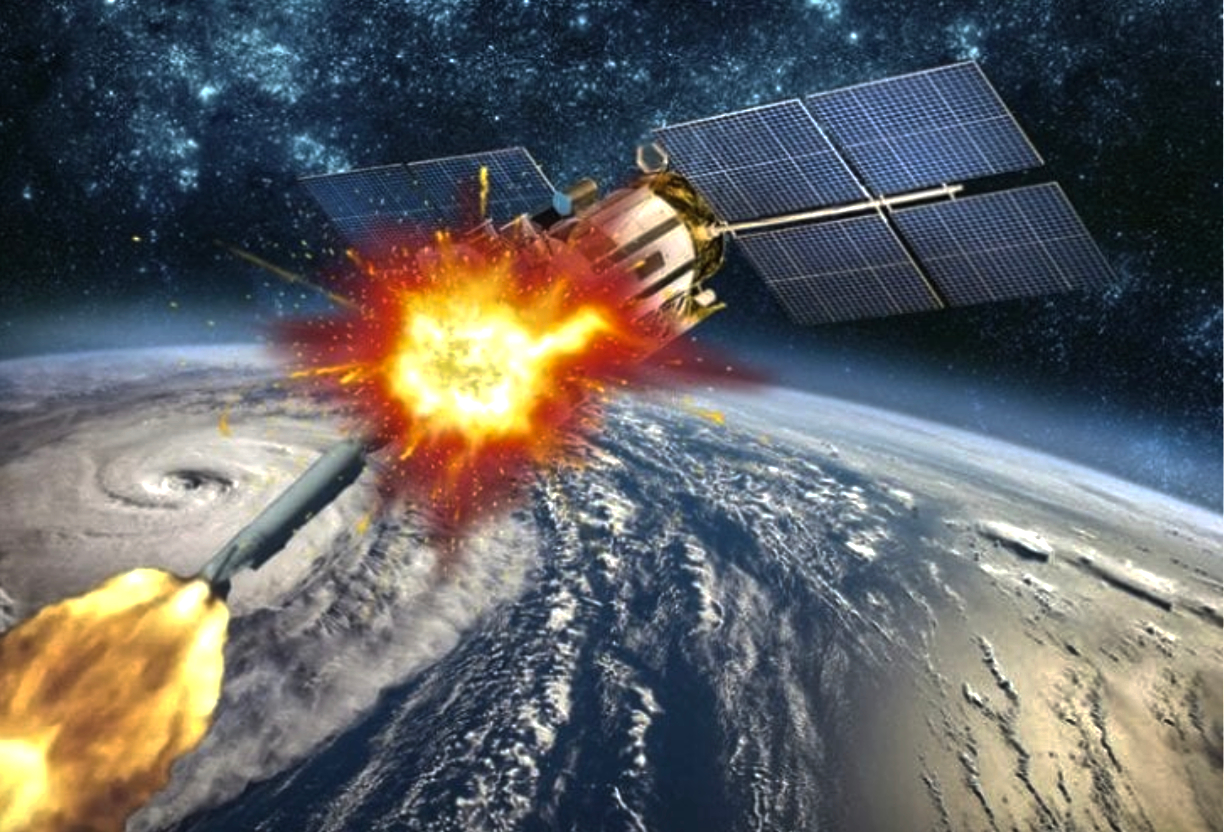Looking back to mid-November of 2021, when Russia destroyed a defunct Soviet satellite orbiting at an altitude of 480 km., gives the world a wider look at Russia’s strategy in light of their invasion into the sovereign country of Ukraine.

Putin wasn’t just after affecting the future regulation of space weapons and desire to be a part of any negotiations, but he was sending a clear signal to the world. Knowing that Russia planned to invade Ukraine prior to the ASAT test, Russia wanted the world to know the nation had the capability to destroy satellites and was willing to use that destructive power. Russia knew the environmental damage an ASAT test at high altitude would cause, including threatening the safety of those onboard the International Space Station (ISS).
The remains of the two-ton Cosmos-1408 satellite are expected to disrupt commercial operations for years to come. Looking further ahead, Russia’s actions have cast uncertainty over the long-term sustainability of space and led to renewed calls for international regulations and norms to govern activity in orbit.
Since the turn of the millennium, the United States, India, China, and now Russia, have all conducted ASAT tests. The targets, techniques and resulting debris have varied in scope. But all of these tests — in addition to the development of other counter-space capabilities — suggest an arms race is well underway.
Space Sustainability in the Wake of Russia’s ASAT Tests
Left unchecked, this gradual weaponization could escalate in a way that undermines access to space for all and gives pause to NATO on that organization’s response options to Russia’s invasion of the Ukraine. The picture is complicated.
Space is the ultimate high ground and infrastructure in orbit is increasingly vital to national security. Developing capabilities that deter attacks on those assets and actively using them against adversaries are two very different elements.
Russia’s November ASAT test is a reminder of how precarious the orbital environment is and that aggressive behavior on behalf of one bad actor can have collateral impacts on the entire industry and space operating environment. The actions of one state could spark a chain of events that would complicate the domain for all.
With so much at risk, it is imperative that the international community sets norms of behavior and strict non-adherence protocols for how to safely and sustainably operate in the space environment. International condemnation followed as more than 1,500 trackable debris fragments were created in Low Earth Orbit (LEO).
An international Treaty is On the Horizon
It’s useful to start with recent developments at the United Nations (UN). Just two weeks before the test was carried out by Russia, the UN General Assembly First Committee — which discusses disarmament, global challenges and threats to peace — approved a resolution to form an open-ended working group. This group will explore potential threats to space sustainability, “make recommendations on possible norms, rules and principles of responsible behaviors,” and “contribute to the negotiation of legally binding instruments.”
Reading between the lines, the end goal is a treaty that will reduce the likelihood of military confrontation in orbit. This will be the most significant international space legislation since the Outer Space Treaty in 1967. A binding agreement will be years in the making but the legislative wheels are now in motion. It’s fair to assume a ban on counter-space activities — or at least on kinetic physical ASAT weapons — will be high on the UN’s agenda.
During that November 1 committee meeting, the Russian Federation pushed for a legally binding instrument to prevent the placing of weapons in outer space. However, that No First Placement resolution did not encompass ground-based ASAT weapons and Russia’s continued development of this capability doesn’t sit comfortably alongside the peaceful rhetoric. Welcome to the complicated world of space diplomacy and interesting bedfellows.
Putting Russia’s ASAT Test into Context
Russia has a long history of successful space endeavors: the first satellite, the first man and woman in orbit, the first space station, and photographing the dark side of the moon. Russia wants to maintain their superpower status in space.

To assess the significance of Russia’s ASAT test and its bearing on the future of space sustainability, it’s important to understand what may have motivated this action.
Russia knows the United States and its allies rely on space technologies to project power globally and Russia wants to negate these advantages. Russia and China both agree on this course of action and both nations have built counterspace capabilities to potentially deter and challenge the U.S. position in space. Russia and China have a long standing, yet complicated partnership around space programs and they continue to partner on ambitious space projects. Furthermore, Russia wanted to demonstrate its capabilities before their use (and development by other nations) is outlawed.
Over the last couple of years, Russia has seen the U.S. create a new and separate service, the U.S. Space Force, as well as a new combatant command, the U.S. Space Command. These armed services are solely focused on space warfighting.
In response over the last year, Russia has tested numerous counterspace capabilities, performed complex RPOs and expanded its space-based military infrastructure1. Russia may not have the budget to create its own Space Force, but developing ASAT capabilities and firing missiles into orbit is an alternative way to counter the United States. Especially as U.S. sanctions are having an effect on Russia’s ability to obtain microchips, according to Rogozin, the head of Russia’s civil Roscosmos program.
Rogozin has threatened to withdraw from the International Space Station in 2025 unless sanctions against Russian space contractors are dropped, and soon2. Additionally, Roscosmos lost revenue, now that the U.S. is not dependent on Russia to launch astronauts and supplies to the ISS since SpaceX has this capability.
The important question now is whether Russia will want to push ahead with further tests. Were Russia’s actions in November a show of force, possibly in response to U.S. actions, a forward step in capability development that provides a bargaining position before UN legislation, or a combination thereof? At the moment, there is more uncertainty than answers.
Counterspace Weapons + Space Sustainability
A catalyst for change
There’s hope that Russia’s ASAT test will be a catalyst ahead of the UN’s Open- Ended Working Group, which will explore space threats and define what constitutes responsible behavior.
During its meetings in 2022 and 2023, the global community could agree that irreversible, kinetic ASAT tests fall into the ‘irresponsible’ category. In time, a binding agreement would serve to reduce tension in what is an increasingly adversarial environment.
Russia’s recent actions raised the profile of these tests and highlighted the issue of space debris more broadly. That much is clear from the December 1 United States Space Priorities Framework, which perhaps includes stronger wording on sustainability than it might have done. In particular is the commitment that the U.S. “will work with other nations to minimize the impact of space activities on the outer space environment…increase efforts to mitigate, track, and remediate space debris” and “advance development and implementation of domestic and international best practices to mitigate the creation of space debris.”
A gloomier perspective is that other nations could follow Russia’s lead and race to conduct their own kinetic tests before any UN measures are agreed upon.
The reality of conflict in space
It’s important to note that kinetic physical ASAT capabilities represent just one weapon in the counterspace arsenal. Direct-ascent missiles are irreversible, clearly attributable and of most concern from the perspective of space sustainability.
There is also a proliferation of more subtle capabilities, including jammers, high- powered lasers and cyberattack techniques. These can block communications, temporarily dazzle or permanently blind satellite sensors and interfere with the transmission of RF signals, respectively.
A 2020 Secure World Foundation report suggests that Russia and China develops and tests a range of counter-space weapons — the U.S., India, France, Iran, and Japan are also building capabilities. This exploration is to be expected at such an early stage in a new space race, but it’s also a reflection of the fact that kinetic conflict and the Kessler Syndrome risk that follows is not in any nation’s best interest.
For all of those nations, counterspace weapons are primarily tools to deter aggression by adversaries. The U.S. Space Force, for example, aims to prevent conflict from starting or extending into space by assuming a position of strength and relying on the traditional deterrence calculus: by denying the advantages or imposing costs related to a specific action from an adversary, that action can be prevented.
The U.S. Under Secretary of Defense for Policy, Colin Kahl, recently spoke about the concept of integrated deterrence, which is particularly important in space where infrastructure and intelligence can be shared between allies to improve resilience. “We have to work alongside our allies and partners so that our adversaries know that they’re not just taking on the United States,” he said. ”They’re taking on a coalition of countries who are committed to upholding a rules-based international order.”
U.S. Space Force Lieutenant General Saltzman put it another way when describing the importance of resilience and having more disaggregated capability on orbit: “If they don’t know what to shoot at, then what’s the benefit of shooting?”
All of which reduces the potential advantage of a space-based attack. In terms of imposing costs, we can look closer to home for a good example.
The threat of mutually assured destruction has, so far, been enough to prevent nuclear war on Earth. The same equation holds in space, where a chain reaction of conflict would quickly render the domain unusable for humankind. That would mean no satellite television, no internet on a flight, no devices that require GPS signals, such as your cell phone, gas station, or ATM machine.
Space is complex enough
From a sustainability perspective, these deterrence measures are promising. But of course, there’s already plenty going on in orbit after decades of launches, accidental collisions, previous ASAT tests, and the recent rise of mega constellations.
As the orbital environment grows more complex, commercial operators also have to embrace the notion of integrated resilience to collaborate, mitigate risk and make data-backed decisions. Situational awareness platforms such as Slingshot Beacon are set to be a critical part of that equation. A safe and sustainable orbit can only be achieved when communications and information are a shared endeavor.
Space is a most challenging domain there is and is increasingly home to vital infrastructure — for national security and everyday lives. Beyond that, it’s the next frontier for exploration and key to the destiny of humanity.
My wish this year and every year is we work together and keep space open for all with the correct tools, safeguards and international standards in place.
References

Charlie McGillis
1 CSIS_Harrison_SpaceThreatAssessment2021.pdf
2 Russian Space Chief Says US Sanctions Keep Satellites Grounded
Author Charlie McGillis is the Vice President of Partnerships at Slingshot Aerospace.




